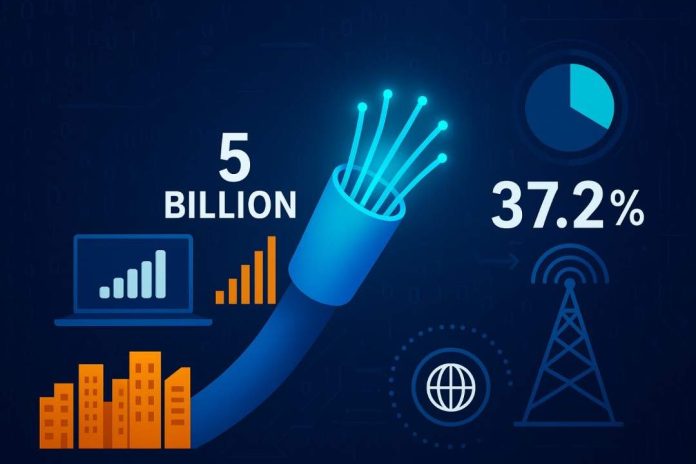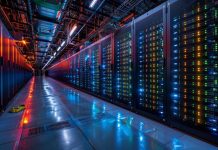The digital ecosystem is evolving faster than ever. Artificial intelligence workloads, rapidly expanding cloud adoption, and increasingly immersive XR applications are transforming how bandwidth is consumed across homes, enterprises, and service provider networks. As a result, global operators are facing an apparent reality: legacy copper and early-generation broadband technologies can no longer support the scale, reliability, and latency needed for these new applications. Fiber networks are now becoming the backbone of modern connectivity, and the demand for upgrades is accelerating worldwide. Statista data also shows that fixed broadband penetration (subscriptions per 100 inhabitants) varies significantly by region; for instance, in 2024, Europe had around 37.2 fixed broadband subscriptions per 100 inhabitants — the highest among global regions.
This article explores why AI, cloud services, and XR technologies are reshaping network requirements and how fiber networks are being modernized to meet the challenge. It also highlights where companies like VSOL contribute to next-generation access solutions through GPON, XGS-PON, and fiber-based CPE products.
Table of contents
AI Workloads Are Reshaping Network Requirements
Artificial intelligence is no longer limited to research labs and data centers. Enterprises use AI for automation, analytics, decision-making, security, and customer engagement. Consumers interact with AI through intelligent assistants, image processing, real-time translation, home automation, and personalized content. These applications create significant upstream and downstream traffic.
1. Massive Data Movement Between Edge and Cloud
Modern AI relies on constant data exchange between endpoints, edge servers, and cloud platforms. Activities like training refinement, inference processing, and model updates require networks capable of delivering multi-gigabit throughput and stable latency. Copper-based networks struggle under sustained uplink demand, while fiber handles symmetrical speeds more efficiently.
2. The Rise of On-Premise and Hybrid AI
More companies are deploying on-premises AI servers for privacy and performance. These systems generate heavy internal traffic that must travel efficiently between branches, devices, and cloud services. Fiber connectivity supports this movement with low loss and high bandwidth, which is crucial for enterprises integrating AI into real-time operations such as manufacturing, surveillance, and logistics.
VSOL’s portfolio of fiber ONUs and OLT platforms supports operators building high-capacity access layers that can deliver the stability AI-enabled businesses require.
Cloud Services Are Increasing Multi-Gigabit Traffic
Cloud computing adoption continues to grow in both corporate and residential environments. From SaaS platforms to cloud gaming and from video collaboration to distributed storage, nearly every digital experience now relies on cloud performance.
1. Bandwidth Demand Driven by Cloud-First Architectures
Modern organizations transition from local servers to cloud-hosted infrastructure. This change multiplies bandwidth requirements because routine tasks now depend on remote processing. Upload speeds are as critical as download speeds, especially when employees share large files, run cloud-native applications, or synchronize backups.
Fiber is uniquely suited to this demand because it naturally supports symmetrical bandwidth. Technologies such as GPON and XGS-PON allow service providers to offer multi-gigabit connections that support high-density cloud usage across offices, hotels, coworking spaces, and educational institutions.
2. Remote and Hybrid Work Intensify Traffic Requirements
Remote work remains a major driver of broadband upgrades. Employees who perform video conferencing, virtualization, remote desktop sessions, and shared digital workflows require strong, stable connectivity. Fiber networks significantly improve user experience by reducing jitter and latency while maintaining higher consistency even during peak hours.
XR Applications Demand Extreme Low Latency and High Bandwidth
Extended Reality, which includes VR, AR, and MR, is expanding in entertainment, education, enterprise training, industrial simulations, and healthcare. These applications stress networks more aggressively than most traditional workloads.
1. High Resolution Streaming and Rendering
Advanced XR systems generate high-density graphics and real-time interactions that require multi-gigabit throughput. To maintain fluid motion and immersive visuals, latency must remain extremely low. Copper connections or older broadband systems often fail to meet these requirements, causing lag, motion delays, or reduced visual quality.
Fiber networks with large bandwidth headroom ensure these experiences remain smooth. As XR content moves toward cloud rendering, the network performance requirements become even higher.
2. Industrial and Enterprise XR Use Cases
In smart manufacturing, maintenance, and logistics, XR tools deliver real-time insights and instructions to workers. These require instantaneous data transmission between servers, cloud models, and wearable devices. Fiber’s low latency and high reliability make it essential for deploying XR in mission-critical environments.
Service providers upgrading to XGS-PON and 10G EPON platforms, including VSOL solutions, are increasingly targeting XR-driven enterprise scenarios.
Why Fiber Is Becoming the Core Technology for Modern Upgrades

The rise of AI, cloud, and XR makes older broadband technologies structurally inadequate. Fiber offers clear advantages for the next decade of digital growth.
1. Multi-Gigabit Speeds with Room to Scale
Fiber enables speeds from 1 Gbps today to 10 Gbps and beyond. Unlike copper, performance does not degrade significantly over distance. As applications become more demanding, operators can upgrade equipment without replacing physical fiber lines.
2. Symmetrical Bandwidth for Modern Workloads
Most next-generation use cases require balanced upstream and downstream traffic. Fiber’s symmetrical capabilities directly support cloud workflows, AI data transfers, XR streaming, and remote collaboration.
3. Reliability and Lower Latency
Fiber is more stable against interference and environmental factors. This reliability is essential for real-time applications such as AI edge inference, XR, and video communication. Reduced latency also improves overall performance for cloud computing and content delivery networks.
4. Lower Maintenance and Long-Term ROI
Although fiber deployment requires investment, long-term maintenance costs are significantly lower than copper. For service providers, upgrading to fiber access networks lowers operational expenses while opening opportunities for high-value gigabit services.
VSOL’s solution ecosystem, which includes compact OLTs, 10G ONUs, and optical CPE devices, aligns with operator strategies to modernize networks efficiently and cost-effectively.
How Service Providers Are Upgrading Their Networks
Across many regions, operators follow similar trends when upgrading their access networks.
1. Transition from GPON to XGS-PON
Many networks start by expanding GPON coverage, then progressively migrate from GPON to XGS-PON to support gigabit and multi-gigabit demand. VSOL’s OLT platforms support multi-mode operation to help operators transition smoothly.
2. Fiber to More Endpoints
Fiber is extending deeper into buildings, campuses, and remote areas. Fiber-to-the-room and fiber-to-the-office deployments are now typical in hotels, enterprises, and MDU complexes, ensuring consistent performance regardless of user density.
3. Cloud Managed Access Equipment
More service providers deploy cloud-managed ONUs and CPE to simplify monitoring and maintenance. This approach supports large-scale fiber rollouts while reducing operational complexity.
Conclusion
AI, cloud computing, and XR applications are transforming how networks are built and used. These technologies demand high bandwidth, low latency, reliability, and symmetrical performance, which copper and early broadband systems cannot meet. Fiber networks provide the necessary foundation for this new digital era. As service providers upgrade infrastructure to support gigabit and multi-gigabit services, companies like VSOL contribute to this evolution with fiber access solutions designed for large-scale, diverse deployment scenarios.










